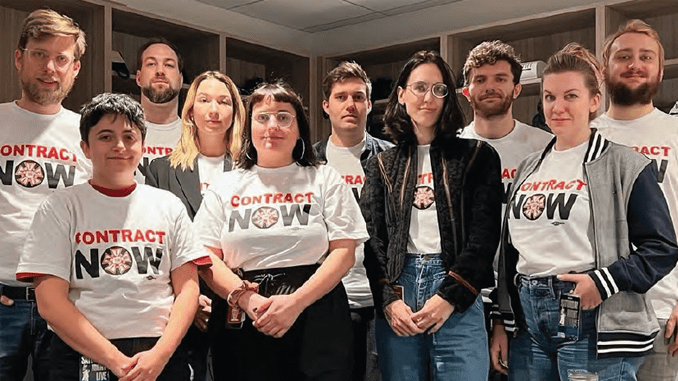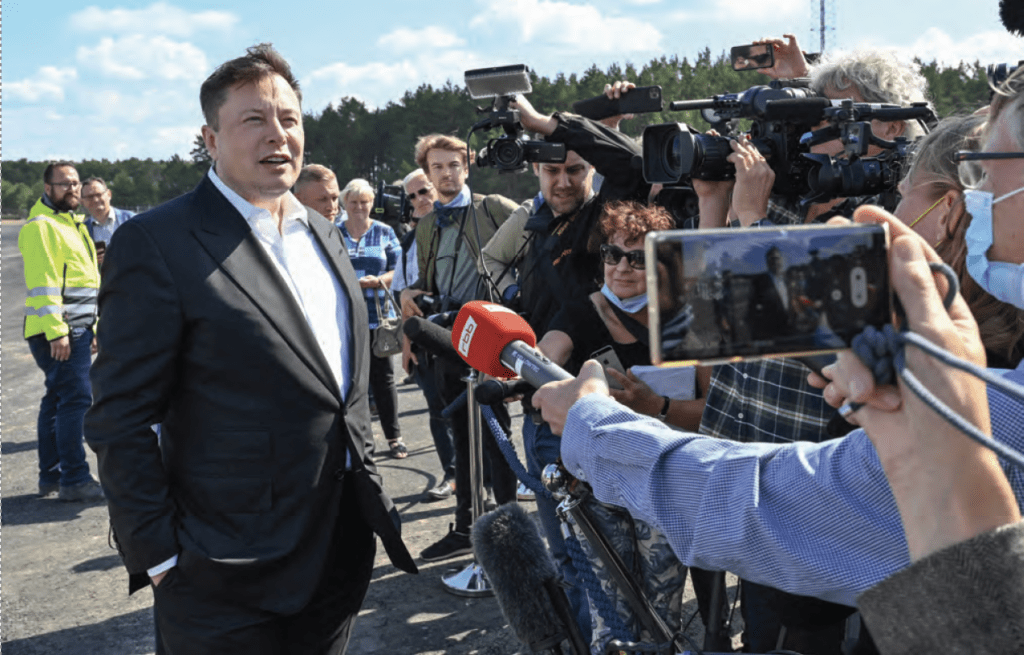
By Rob Callahan
There’s a sign on the receptionist’s desk in the West L.A. offices of the National Labor Relations Board: “We Guarantee Fast Service, No Matter How Long It Takes.”
Certain jokes are funny because they’re true. This particular joke, to my sense of humor, is a bit too true to be funny.
Take an illustrative case: Half a decade ago, a mercurial billionaire casually fired off a public threat to thousands of his employees. It came in the form of a tweet sent about15 minutes before midnight on the evening of May 20, 2018. With 248 characters tapped into a mobile device, Elon Musk warned employees of the automaker Tesla that they would lose their stock options in the company if they voted to unionize with the United Auto Workers.
That tweet broke the law. But the Law, as we will see, was already and remains broken. Bosses can fight the Law, and, although the Law may eventually win, any such victory might be so long deferred as to be rendered something close to a stalemate.
The National Labor Relations Act — the federal law that enshrines employees’ rights to organize — was enacted in 1935, an age when such things as tweets and Teslas would have seemed the stuff of science fiction. But bosses’ abuse of their power is timeless, and the Act fully anticipated strong-arming of the kind contained in Musk’s 2018 tweet. The law explicitly makes it illegal “to interfere with, restrain, or coerce employees in the exercise of [their] rights.” The National Labor Relations Board (NLRB) — the agency responsible for administering the National Labor Relations Act; they are, if you will, the Law in matters of labor law — has long and repeatedly ruled that threatened repercussions (e.g., the loss of compensation) constitute precisely that kind of prohibited coercion.
Different umps will make different calls. And I’m no umpire: I’m a partisan, not a neutral; I’ll take labor’s versus management’s side each and every time. That said, Musk’s tweet threatening Tesla workers’ stock options didn’t fall into some ambiguous gray area of the law — it wasn’t even close to the line. Don’t take my word for it: the three-member panel that unanimously concluded Musk’s tweet was illegally coercive included two staunchly pro-management Trump appointees, lawyers who’d made careers out of fighting unions on behalf of bosses. Decades of case law have afforded union-busting employers a lot of latitude and loopholes permitting them to lean hard on their employees, without technically running afoul of the Act. But even the management-side attorneys Trump installed on the Labor Board, whose very raison d’être was to limit labor’s power, agreed that Musk’s tweet was well out of bounds.
One of the curious things about our information age is the fact of digital permanence. We can now never really dispose of our throwaway thoughts; ephemera endure (often embarrassingly) somewhere in the cloud for all eternity. Even so, it seems odd for us to be paying attention to a tweet five years after the moment in which it was hastily tapped out and sent off into the world. Indeed, the fact that we’re still talking about it, after the passage of so much time, is the point: when management comes at us with the instantaneous speed of tweets and Teslas, the law lumbers onto the scene with carrier pigeons and Conestoga wagons. It takes only a blink of an eye for bosses to union-bust, but what passes for justice plods along at the pace of a burdened, bumbling, broken-down bureaucracy.
Let’s review this tweet’s life to date. Musk made the threat to take away his employees’ stock options, were they to unionize, on May 20, 2018. Only a few days later — on May 23, 2018 — lawyers for the United Auto Workers (UAW) filed charges with the NLRB. An investigation followed, and it took a few months — until August 23, 2018 — for the Regional Director of the NLRB’s Region 32 to issue a formal complaint, effectively a decision to prosecute Tesla for threatening workers. Another year passed before an administrative law judge ruled that the tweet was indeed unlawful. But then it took an additional two years — until March 25, 2021 — for the NLRB to definitively issue a ruling on Tesla’s appeal, reaffirming the illegality of the tweet and ordering it deleted.

It would be absurd enough for one late-night tweet to precipitate a three-year legal battle, but it didn’t end there. Tesla appealed the NLRB’s decision, and it wasn’t for yet another two years — that is, until March 31, 2023 — that the U.S. 5th Circuit Court of Appeals upheld the NLRB’s ruling that Musk and Tesla broke the law. Nearly five years after the offending threat, the Court of Appeals reaffirmed the order that Musk delete the tweet.
As a compulsive Twitter user who frequently faces blowback for his online trolling, Elon Musk has deleted a lot of tweets over the course of his microblogging career. But the 2018 tweet threatening Tesla workers still remains undeleted to this day, notwithstanding multiple orders to retract it. After five years of litigation, with wins at every step along the way, the UAW and all of its lawyers have yet to undo 248 keystrokes.
Slow justice is no justice. When those who abuse their power are able to perpetually postpone any repercussions, there are effectively no checks upon their power.
I’m writing about this particular case because it has been again in the news, owing to the 5th Circuit’s recent decision and owing, of course, to Musk’s celebrity. But make no mistake, the matter of that Tesla tweet isn’t especially remarkable: there are many such cases that languish for years and years in unresolved litigation, and they are usually about matters more material than just bad tweets. Indeed, the Tesla case, although it generated headlines chiefly for Musk’s threat on Twitter, was consolidated with a number of other, arguably weightier charges against Tesla for related violations of labor law at its Fremont, Calif., plant, including the retaliatory firing of a union activist. The NLRB regularly handles such cases of coercive or otherwise illegal behavior, including cases in which workers suffer real damages. And those cases often drag on for months or years; when workers see any remedy, it is often too little and far too late to undo the harm done.
The delay and consequent denial of justice at the NLRB extends as well to representation cases — i.e., cases in which workers seek recognition of their chosen union. In July of 2021, hair and makeup artists working for the Atlanta Opera unanimously voted to be represented by our sister local, IATSE Local 798; the Labor Board has still yet to rule on the employer’s claim that these artists are independent contractors without the right to organize. Similarly, in October of last year, music supervisors on Netflix productions went to the NLRB to seek IATSE representation, and the employer has delayed their getting a chance to vote by alleging that they, too, are independent contractors rather than employees. Workplace democracy is gravely undermined when employers’ lawyers can delay union elections or prevent the results of workers’ votes from going into effect.
Elections for public offices matter, but the problem of plodding justice in the area of labor law isn’t one that can be solved simply by voting different politicians into power. President Biden is arguably the most pro-union president this country has had. Jennifer Abruzzo, whom Biden appointed as General Counsel for the NLRB, is a pro-worker progressive who has demonstrated a willingness to ambitiously reinterpret labor law in order to restore the National Labor Relations Act’s express purpose to promote collective bargaining. The Senate Health, Education, Labor, and Pension (HELP) Committee, under the chairmanship of Sen. Bernie Sanders of Vermont, has publicly named and shamed union-busters, including Starbucks’s former CEO Howard Schultz (whom then-candidate Clinton had eyed to serve as her Secretary of Labor only seven years ago). But even with relatively sympathetic figures operating the levers of power, the machinery simply doesn’t work for workers seeking timely justice.

To be clear, this isn’t only an issue of a sluggish NLRB, and the hard-working civil servants who work for the Board do the best they can. The NLRB is understaffed and overburdened, with caseloads having spiked in recent years. But even in matters that skirt entirely the bureaucracy of the NLRB (contract negotiations or grievances and arbitrations, for instance), any affair in which workers are chiefly reliant upon lawyers or even union officials to effect change on their behalf can drag on at such length that whatever justice is eventually achieved is undercut by its deferral.
A few years ago, I was contacted by an editor confused about why the unscripted show they were working on wasn’t covered under a union agreement, even though the production company in question was a term signatory. A bit of research revealed that the production company had created a shell company in order to try to avoid its contractual obligations. I talked to several members of the post crew, letting folks know that their employer was in material breach of their contract and that we could seek a remedy through the grievance procedure, unless they collectively wanted to force the issue by taking direct action. This particular crew didn’t have a lot of appetite for taking matters into their own hands, so the IATSE filed a formal grievance through its legal counsel. It was a fairly straightforward case, but, even so, it took very nearly a year to reach a settlement, and many more months before the company actually followed through on payment of retroactive health and pension contributions they agreed to under the settlement.
I’ve presented a grim picture of elusive justice, justice pushed and postponed, ever receding with the distant horizon. And it’s true that I have limited faith in pursuing fixes through bureaucratic channels. But that doesn’t mean that there’s no hope.
Perhaps you followed the news earlier this year about the editorial crew of “Saturday Night Live.” Most of the show’s crafts have long been covered by union contracts, and the bulk of post-production employees working on NBCUniversal shows broadcast out of 30 Rockefeller Center are in the jurisdiction of National Alliance of Broadcast Employees and Technicians (NABET) contracts. But a gap in NABET’s jurisdiction had rendered the film editorial crew that puts together the show’s pre-shot sketches — a bunch of about 20 freelance employees in various classifications — effectively orphaned for some time. Their pay was well below industry standards, and they hoped to improve other aspects of their jobs, as well. So last October, at the start of the current season of the show, they decided to organize with the Editors Guild.
We were able to secure union recognition for this crew in short order — circumventing any NLRB involvement — and had hoped that a first contract could also be achieved with a minimum of time and fuss. “SNL”’s film crew is an operation that moves at breakneck speed — their shorts go from concept to screen over the course of only a few days, and editors are often frantically putting the finishing touches on them up to a few minutes before they air — so the crew knew the show was capable of making complicated things happen fast when there was a need.
Unfortunately, we soon learned that the suits at NBCU weren’t accustomed to moving so speedily and didn’t feel any particular imperative to pick up their pace.
Under the National Labor Relations Act, once a union wins recognition for a group of employees, the employer is required to bargain in good faith with that employer. But they’re not required to actually agree to anything, nor are they required to make contract negotiations a particular priority. And NBCU, a subsidiary of notorious union-buster Comcast, rarely demonstrates much interest in prioritizing contract talks. NBCU’s relationship with the News Guild, in fact, is a case study in employer recalcitrance and the interminable delays such recalcitrance occasions. In December of 2019, a group of about 150 journalists in NBC News’ digital division organized with the News Guild of New York. More than three years later, those workers still don’t have a first contract, and NBCU has shown little sign of taking their contract talks seriously, despite the company’s having been cited by the NLRB for failure to negotiate in good faith over mandatory terms of bargaining. The ongoing ordeal of NBC News workers was and is an object lesson in just how little effective legal recourse there is for employees whose employers refuse to take their obligation to bargain seriously.
The SNL editorial crew is close-knit and built for speed, and after only a few weeks of NBCU’s foot-dragging, they decided they would need to take matters into their own hands. In late January of this year, the crew gathered over Zoom to review what progress had been made in talks; there had been effectively none. After some discussion, the crew took a vote and unanimously decided that they were willing to strike if needed to achieve a fair deal, at a time when such a strike would have the most leverage.
We printed up shirts emblazoned with “CONTRACT NOW” and every crew mem-ber wore them to work at 30 Rock each week as a visible manifestation of their growing impatience. Stories about the prospect of an editorial strike at SNL began to appear in the trades, and NBCU immediately started to take notice. Within hours of the first article appearing in The Hollywood Reporter, NBCU responded to a prior request from the Guild for management’s availability to meet for future bargaining sessions. Management scheduled more frequent meetings, responded to union proposals more quickly, and began to reach agreement on some of the less consequential, more standardized elements of a union contract — what negotiators refer to as boilerplate. Perhaps as importantly, colleagues in other departments also took notice, and many took to donning “CONTRACT NOW” shirts in solidarity with the editorial crew. Several cast members posted messages of support on social media and even wore the “CONTRACT NOW” shirts on camera at the end of one episode in February.
Still, on the substantive issues of greatest import to the crew, management and the union remained far apart. Management felt enough pressure to make a show of going through the motions of negotiations, but they remained in little rush to reach an actual deal. Meanwhile, the end of the season was approaching, which meant that there was limited time during which the crew would retain real leverage. So, on March 9, the crew announced a date. If an agreement wasn’t in place before the crew returned from a scheduled hiatus to work on the April 1 show, they would walk off the job and picket to disrupt the scheduled broadcast.
Suddenly, with the deadline looming, media attention intensified, the pace of negotiations increased dramatically, and management exhibited a newfound urgency to get a deal done. More progress was made over the course of the next week than had been made in the previous months of talks. Cathy Repola, leading the Guild’s negotiating team, said that she had never seen such an abrupt change of attitude from management in all her decades of union negotiations. On March 17, eight days after the declaration of a strike deadline, we had a tentative agreement — and a good one. In addition to significant movement on other issues of importance to them, the SNL editorial crew scored real money: immediate raises ranging from 7.5% to 33.5%, and cumulative increases of up to 60% over the life of the contract. When the crew met the following week to ratify the tentative agreement, the vote in favor was unanimous.
The lesson of the “SNL” campaign is straightforward. Corporations are set up to manage and modulate legal action. Reliance on the law or upon the conventional routine channels of labor-management relations will prove limiting with respect to incentivizing a recalcitrant employer to reach a deal. But where legal action is manageable, direct action has the potential to create a crisis for the employer, and the prospect of such a crisis is often the only route through a logjam.
It’s not a subtle or sophisticated lesson, but it’s a helpful reminder that our ability to get what we want, on our timetable, ultimately comes down to our ability to twist arms. And however much our culture may teach us that authority is invested in people who tote briefcases and wear suits, truly transformative power comes from the solidarity of folks who can handle tools and who sport T-shirts. When we want real change, on our own schedule, we need to look not to the law or to bureaucrats but to one another.






